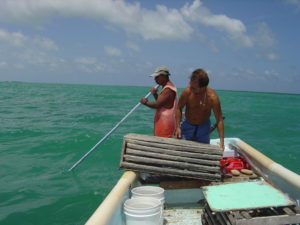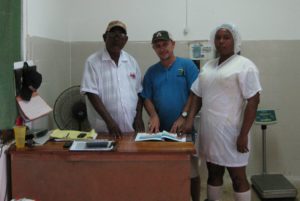Why Teach Culturally Appropriate Fundamental Ecosystem Conservation Concepts in Primary and Secondary Schools in the Fishing Communities of the Greater Caribbean Basin?
“Our language is like a pearl inside a shell. The shell is like the people that carry the language. If our language is taken away, then that would be like a pearl that is gone. We would be like an empty oyster shell.” —Yurranydjil Dhurrkay, Galiwin’ku, North East Arnhem Land, Australia
UNESCO has determined that as much as 40% of the global population does not have access to an education in a language they understand. Being able to communicate effectively in an individual’s first or home language connects a person to their ethnic group, helps to shape a persons’ identity and strengthen their feelings of pride and self-worth. Language is integral in affirming and maintaining well-being, self-esteem and a strong sense of identity. Languages contain complex understandings of a person’s culture and their connection with their surrounding ecosystems. Cultural heritage and knowledge is passed on throughout each generation by language. There is a wealth of evidence that supports the positive associations of health, education and employment outcomes as well as general well-being with language and culture. Indigenous languages keep people connected to culture.
Article 14 of the United Nation’s Declaration of the Rights of Indigenous People states that indigenous children have the right to education in their own language. Not providing youth the opportunity to an education in a language they understand can have severe consequences, not only to the individual, but to the family, the local community and the nation. It can create resentment towards members of the dominant language group and possibly lead to civil unrest. It can constrain people from achieving the full potential necessary to contribute wholly to their family, the local community and to the greater identity of their nation. In addition, the inability to learn in one’s home language inhibits the necessary understanding for adequate marine conservation in the region. While marine resources are crucial for the wellbeing of coastal communities in the region, marine resources are facing dire challenges in terms of climate change, overexploitation, illegal fishing and inadequate governance. This can negatively affect families, local communities, nations and international value chains.
 None of the coastal communities of the greater Caribbean basin are receiving an institutionalized education in marine conservation concepts in order for them to be able to fully understand how to protect these resources which are so important for food security, livelihood and employment on which their families are dependent. Educating fisher folk and youth in marine conservation in their home language provides the opportunity not only to teach them about the importance of marine conservation, it will also support improving marine governance in the region as it provides opportunities to learn from local mechanisms and understandings of marine conservation already in place based on cultural heritage and knowledge in relation to the use of natural resources. As a large majority of the population currently does not have access to an education in their home language this project will help address this gap.
None of the coastal communities of the greater Caribbean basin are receiving an institutionalized education in marine conservation concepts in order for them to be able to fully understand how to protect these resources which are so important for food security, livelihood and employment on which their families are dependent. Educating fisher folk and youth in marine conservation in their home language provides the opportunity not only to teach them about the importance of marine conservation, it will also support improving marine governance in the region as it provides opportunities to learn from local mechanisms and understandings of marine conservation already in place based on cultural heritage and knowledge in relation to the use of natural resources. As a large majority of the population currently does not have access to an education in their home language this project will help address this gap.
The purpose of this project is to create curriculum and educational instruments using local Ministry of Education Guidelines and input from the local Fisheries Department to teach fundamental marine conservation concepts to fishers and young people in coastal communities in their home language. We will also use their cultural heritage and home languages of these different linguistic groups to engage these young people in new manner. This innovating new type of curriculum will provide fishers and youth with a new understanding necessary to ensure marine conservation. It will also help them to self-identify with these concepts, and provide them with a greater sense of pride and ownership of these ideas. This is crucial as to enhance their entry into the fisheries sector or the marine tourism industry and become engaged consumers of local marine products to help preserve these resources for the future.
 Marine resources provide significant benefits to the country, the Caribbean region and beyond. It provides food security, livelihood and employment at the local level and as a large part of the catch is exported it provides significant foreign exchange earnings at the national level. It thus provides significant economic gains and ties the country with international consumers in Europe, North America and Eastern Asia. It is therefore imperative that these resources be protected from over-exploitation and used in a sustainable manner so that these marine products will be available in the future. One way to achieve this goal is to teach the same fundamental marine conservation concepts across the region in an institutional setting. An education curriculum to teach these fundamental marine conservation concepts will also protect and strengthen these foreign, national and local economic structures that are dependent upon healthy marine ecosystems.
Marine resources provide significant benefits to the country, the Caribbean region and beyond. It provides food security, livelihood and employment at the local level and as a large part of the catch is exported it provides significant foreign exchange earnings at the national level. It thus provides significant economic gains and ties the country with international consumers in Europe, North America and Eastern Asia. It is therefore imperative that these resources be protected from over-exploitation and used in a sustainable manner so that these marine products will be available in the future. One way to achieve this goal is to teach the same fundamental marine conservation concepts across the region in an institutional setting. An education curriculum to teach these fundamental marine conservation concepts will also protect and strengthen these foreign, national and local economic structures that are dependent upon healthy marine ecosystems.
In multi-ethnic and multi-linguistic countries such as those in the greater Caribbean basin, an education curriculum only in the dominant language can hinder learning in several ways. Many times the members of the dominant language group are perceived as aggressors and this causes resentment within the minority linguistic groups, furthermore the concepts taught may not be recognized as their own. Indeed they may be perceived as something else being forced upon them by members of the dominant language group. Also, the minority language speaker may not be satisfactorily fluent in the dominant language to fully embrace any concepts taught in an institutional setting. We will address these issues and others by using the languages of these coastal communities to not only teach these concepts but to also give these groups an apparatus to self-identify with the concepts being taught and thus embolden these young people with a greater sense of responsibility for the protection of these shared resources which their lives and their families are dependent upon in one form or another.
Whereas fluency in the majority language of a country is essential to maximum mobility of its citizens, the majority language should be taught as a secondary language in the schools where it is not the home language of the student. To increase the efficiency of an education, the child’s home language should be taught as the language of instruction for the first three years in the classroom; the majority language of the country should then be integrated later as a secondary language. When language is used in this manner the child will see that their language (heritage) is being respected and not oppressed. This will lead to a greater understanding of the lessons and thus better prepare them to maintain their families and increase their contribution within their communities and their country. This also leads to an increased sense of being a part of the national community and begins to diminish the sense of oppression from the majority language group. In addition this will be an exercise in mutual veneration exhibited by both linguistic groups that was initiated by the majority language group. This can also direct these linguistic groups down a path of less resentment and greater understanding and respect that can lead to greater cooperation between the majority linguistic group and these communities. This also reduces suspicion of outside groups and fosters superior relationships between these communities and the government and other outside organizations.
